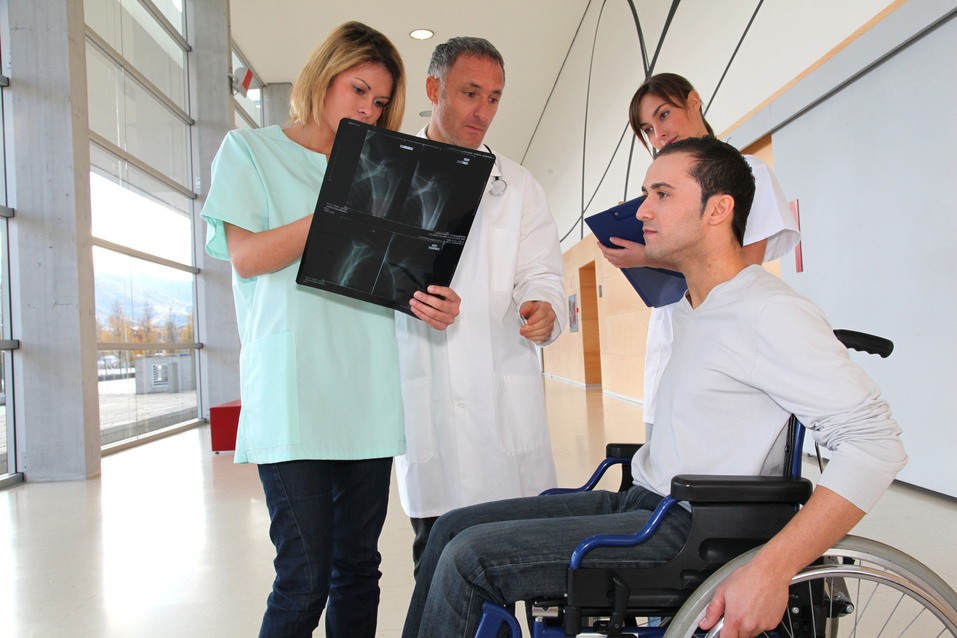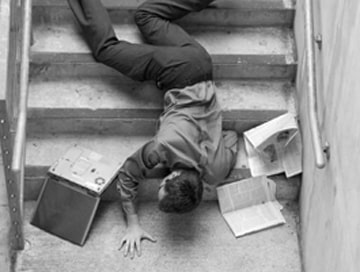When most people think of a spinal cord injury, they have visions of life in a wheelchair, entirely numb below a certain point.
This certainly does happen – all too frequently – but it’s important to note that not all spinal cord injuries result in complete or partial paralysis, or even numbness.
But one thing’s for certain: pain is involved in all spinal cord injuries. Lots and lots of pain.
And beyond chronic aches and limited mobility, some spinal cord injuries leave the victim with little or no control of their bowels or bladder, for instance.
So if you’re ever in an accident and you hurt your back, you need to take it seriously. There’s a lot to consider beyond simply seeing a doctor and getting medical treatment. You’re likely to have recurring medical bills, with physical therapy stacked on top. And if you lose wages due to not being able to work, that’s extra lost money.
And you need to know right now: your insurance company is NOT going to cover all that. In fact, they’re going to do everything they can to avoid paying for it.
So call Kuzyk Law – we know the insurance industry, and we know how to get the maximum compensation for spinal cord injury victims.
24 HOURS: (661) 945-6969
If you or someone you love has suffered a spinal injury, keep reading – there’s lots you need to know, and it’s all here…
What is a Spinal Cord Injury?
A spinal cord injury (SCI) results whenever there has been damage to any part of the spinal cord or nerves at the end of the spinal canal. Such injuries can cause permanent changes in strength, sensation and other bodily functions below the injury site.
There’s no magic bullet for a spinal injury. Some are cause chronic pain throughout the rest of the body, some require surgery – or multiple surgeries – and some result in permanent paralysis.
Nationally, it’s a bigger problem than most people think. There are 17,500 new cases of spinal cord injury each year, with 285,000 people in the U.S. currently living with SCI. The average age of injury is 42 years, with males accounting for 81 percent of all new SCI cases. Nearly half of all cases since 2010 have resulted in incomplete tetraplegia involving partial damage to the spinal cord, leaving many people with impaired motor control and sensory function. Others may have feeling in their limbs but little or no movement.
The spinal column is an extremely sensitive area of the body, comprised of 33 bones. Connected to the brain, both of these work together to form the central nervous system. A spinal cord injury can result from a sudden injury to the spine that causes a fracture, or that dislocates, compresses or crushes one or more of the vertebrae. Other times, injury can result from a penetration or cutting of the cord, as in the case of a gunshot wound or knife wound, for example.
Following are the most common causes of SCI:
- Motor vehicle accident (42%)
- Falls (26%)
- Acts of violence (15%)
- Sports injuries (7%)
- Other (8%)
The lasting effects of a spinal cord injury aren’t always immediately clear. The victim may sustain an injury to the back or neck, such as in a car accident, with no immediate loss of sensation; however, as time goes on and that injury causes bleeding, swelling, inflammation and fluid accumulation around the spinal cord, more serious effects can start to emerge.
How an injury affects a person depends largely on the area of the spine that was damaged, and the severity of that injury.
The bottom line is this: when you sustain an injury to your spinal cord, no matter how mild you may assume at first, get to a doctor or the ER right away. You never know the extent of your injury until you have been seen by a medical doctor. Even then, those doctors may not have all the answers. It’s better to cover yourself now.
Spinal cord injuries that result in paralysis, and even those that don’t, represent life-changing events every time. Regardless of the degree of your injury, a sudden disability can be frightening and confusing, and adapting to your new lifestyle is no easy task.
Treatments and rehabilitation allow many people with SCI to lead productive, independent lives – but at tremendous financial cost.
Don’t put your future into the hands of an insurance company. Call the spinal cord injury lawyers at Kuzyk Law to start securing a financial future that will enable you to handle the astronomical medical and rehab bills that are coming your way.
We are happy to provide you with a free initial case consultation. Call us at 661-945-6969.
The High Cost of Spinal Cord Injury
All at once, you are faced with some pretty tough questions: how will your spinal cord injury affect your everyday activities? How will your personal relationships and long-term happiness play out over the long term? Will you still be able to work? If not, how will you pay the bills? Should you take the insurance company offering just to get some money coming in?
To that last question, we say NO.
You may be tempted. You may just want the whole matter to go away so you can get a bit of cash, pay some bills and start healing.
But we know better. We have been handling spinal cord injury cases for four decades and we know how the insurance companies operate. Their style is to pay you off with as little as possible to make you go away so they protect their own profits.
Trust us, there may be more money out there for you. And make no mistake: you will need it. Average yearly expenses for SCI can hit as much as $1 million for the first year of treatment for the worst kind of injury (total paralysis) and nearly $190,000 each year thereafter. The estimated lifetime costs by age at injury can reach as high as $4.7 million for 25 year olds and $2.6 million for 50 year olds.
The life expectancy for a victim of SCI is much lower than that of those who don’t have an SCI, with secondary health concerns plaguing the remainder of life, such as spasticity, urinary tract infections, bowel and bladder problems, neuropathic pain, shoulder and joint pain, fractures, psychological distress and depression, and respiratory complications. The leading causes of death for people with SCIs include pneumonia, pulmonary embolism, septicemia and kidney failure.
The average length of stay for SCI injury is 12 days in the hospital and an average of 37 days in a rehabilitation center.
Ongoing home care is the most popular option following a spinal cord injury, followed by group living home and nursing home.
Depending on the extent of your injury, you may face a lifetime of long-term medical care issues, transportation, housing, rehabilitation, and consults with physicians, neurosurgeons, psychologists and other experts.
With lifetime costs reaching nearly $5 million and beyond for the most severe cases, take a look at that meager insurance company payout and think again if it will be adequate for your treatment. Again, not all cases result in this grim outlook. But the challenging thing about spinal cord injuries is that, like traumatic brain injury, no one knows what the long-term prognosis will end up being – not even the best team of doctors assigned to your case.
We believe it’s better to arm yourself with the tools necessary to protect yourself financially than to face crushing debt or bankruptcy later on.
Determining what your case is worth starts with a free call to Kuzyk Law at 661-945-6969.
Types of Spinal Cord Injuries
As noted above, not all spinal cord injuries are the same. The degree of loss of function and paralysis depends greatly on the location of the injury on the spinal column. In addition, how the injury occurred will also factor into the severity and duration of the effects. Here are the major types of spinal cord injury:
- Severed spinal cord
- Crushed spinal cord
- Compression injury
- Vertebral dislocation/fracture (broken back)
- Other types of external trauma
Most times, symptoms appear immediately after the injury. However, in some cases, symptoms can develop slowly thereafter, due to swelling or inflammation around the injury site. Other times, in the case of an infection or tumor, symptoms emerge gradually due to the build-up of pressure on the spinal cord.
In general, the symptoms of spinal cord injury will vary depending on where the injury took place, as well as whether the injury is complete or incomplete. Incomplete injuries leave patients with remaining function of their bodies below the level of injury. Complete injuries leave them with no function at all below the level of injury.
General symptoms of SCI include:
- Weakness
- Poor coordination
- Paralysis below the level of injury
- Numbness, tingling, or loss of sensation
- Loss of bowel control or bladder control
- Pain
- Back pain or pressure in neck, head or back
- Loss of normal sexual function/infertility
- Loss or altered sensation, i.e., loss of ability to feel heat, cold and touch
- Exaggerated reflex activities or spasms
- Difficulty breathing or coughing
If you have been the victim of a spinal cord injury due to the fault of another party but have NOT suffered paralysis, you may assume you have no legal or financial recourse. This is untrue. In our four decades of experience acting as the trusted personal injury attorneys for Southern California, we have seen countless SCI cases that involve all degrees of injury and resulting symptoms. We are here to tell you that you may have a case even if you don’t experience lasting numbness or paralysis.
If chronic, debilitating pain is present as a result of your injuries, you deserve to be compensated. You don’t have to be paralyzed to miss work, incur mountains of medical bills, face regular rehab and miss out on a full life of pain-free activities. So much more goes into a spinal cord injury than just loss of sensation.
Those who have sustained spinal cord injuries often have difficulty performing even the simplest of tasks. In addition to suffering great pain, particularly in the upper and lower back, victims find they can no longer perform or enjoy the tasks they used to before the accident. On top of that, they may suffer from bladder dysfunction that requires a catheter, bowel dysfunction (another embarrassing and inconvenient side effect of SCI no one talks about), and even osteoporosis, spasticity and syringomyelia, which only shows up months or years after the initial injury but causes gradual numbness and weakness in the extremities. This is a prime example of why you should be checked out immediately after suffering an injury of any kind to your spinal cord! You never know when those effects will make themselves known.
In order to understand the degree to which any of these injuries can occur, it’s necessary to take a quick anatomy lesson…
Anatomy of a Spinal Cord Injury
Not all spinal injuries result in paralysis, but many do. It all depends on where the injury occurred on the spinal column, as well as the severity of the injury. Here is a look at the effects of injury to each portion of the spinal column.
- Injuries to the cervical vertebrae, or neck, can affect how signals are controlled in the head, neck, shoulders, arms, hands and diaphragm.
- Injuries to the thoracic vertebrae can interrupt signals to the chest muscles, back muscles and abdomen.
- Injuries to the lumbar vertebrae, or lower back, can affect signals to the lower abdomen, lower back, buttocks and parts of the legs.
- Injuries to the sacral vertebrae, or hip area, can affect the lower thighs, lower legs, feet, and external genital organs.
- Coccygeal vertebrae injuries affect the sensation on the skin of the lower back.
When damage occurs to high-cervical nerves, this is when the most severe spinal cord injury can result. This is characterized by paralysis in the arms, hands, trunk and legs, which is called quadriplegia. Think of Christopher Reeve, who severed his top two vertebrae (C-1 and C-2) after being thrown from his horse. This is the worst kind of injury the spinal cord can sustain, resulting in the need for complete assistance with activities of daily living, breathing tube and 24/7 personal care. The higher up the spinal cord the damage is inflicted, the worse the consequences. The reverse is true: the lower down the back the injury is, the lower the chance of lasting paralysis.
Not all injuries are as severe as Reeve’s. In fact, most are not. For example, when the injury affects the lumbar nerves, which are lower down on the spine, this typically results in some loss of function in the hips and legs. There may also be little to no control of bowel or bladder, voluntarily, but patients are able to manage independently with designated equipment. A wheelchair and braces may be needed but walking is still a possibility.
Other injuries are considered minor, in that no lasting paralysis has occurred. However, the victim is left with debilitating pain the rest of his life.
As you can see, spinal cord injuries are more varied than just “stuck in a wheelchair.” A wheelchair may or may not be necessary from case to case, but one thing is always certain: pain.
There is no reason for you to live with chronic pain or any of the other symptoms associated with spinal cord injury – particularly if the accident occurred at the hands of another.
No matter how you have been affected by your accident, it’s important to place a call to Kuzyk Law at 661-945-6969.
Why You Need an Attorney Skilled in Spinal Cord Injury
Negligence is often at the heart of any spinal cord injury case, particularly car accidents or motorcycle accidents, which is the most common we see. When an accident occurs through the action or inaction of another party, you are entitled to monetary compensation. Kuzyk Law has vast experience compiling SCI cases that prove that the other party was at fault. Thus, you may be able to collect monetary damages for lost wages, lost or decreased future wages, prospective medical care, and ongoing pain and suffering.
It’s not as easy as it sounds. First, we have to speak with you to determine the facts of the case and whether you even have a case. Going forward, we will have to engage in an exhaustive analysis into the facts, consulting with law enforcement (if applicable) as well as your team of doctors.
We know this is a traumatizing time for you and your family. The last thing you want to think about is money when you’re trying to save your own life and heal from your injuries.
That’s OK. The first step is to call us at Kuzyk Law. We have a specialized team of skilled personal injury attorneys who have settled more than 100,000 cases successfully. We’ll know what to do next.
We offer a free initial consultation and are available 24/7. There’s no need to wait to call us. If you are unable to come to our office due to your injury, we will come to your home or hospital. Proud to serve Palmdale, Lancaster, Little Rock, Los Angeles, Bakersfield, San Bernardino and all surrounding communities, Kuzyk Law brings the expertise in spinal cord injuries you need to rely on for results.
The impact of a spinal cord injury on the lives of the victims and their families can be traumatic and life-altering. Skyrocketing medical and rehab costs can quickly drain your savings, with an emotional toll that can be even more costly. If you or a family member have been in an accident and suffered a spinal cord injury, Kyzyl Law can help you get financial compensation for your injuries and losses.
Don’t wait another second! Call us now at 661-945-6969.

















